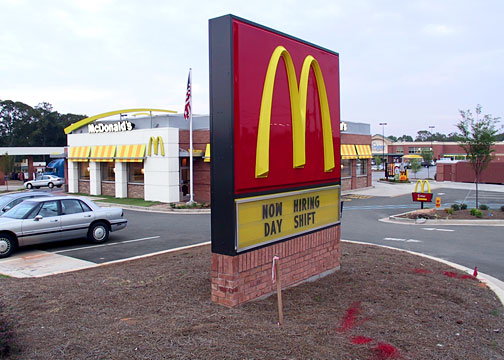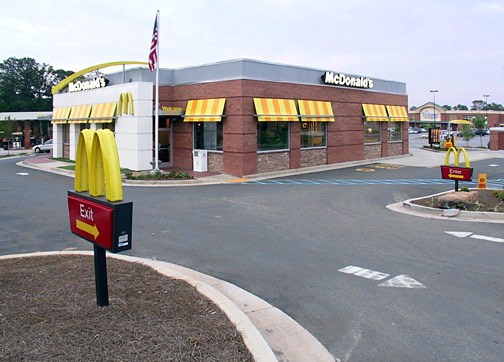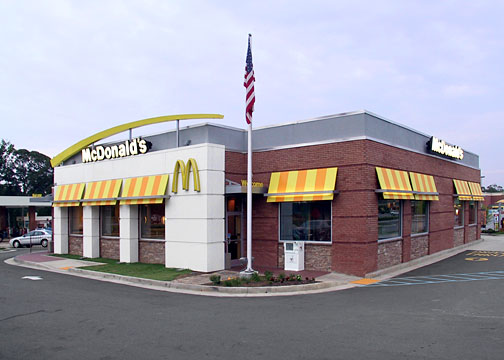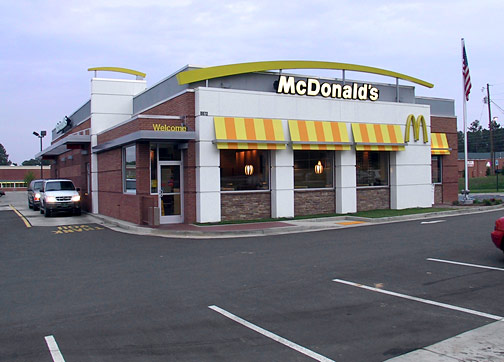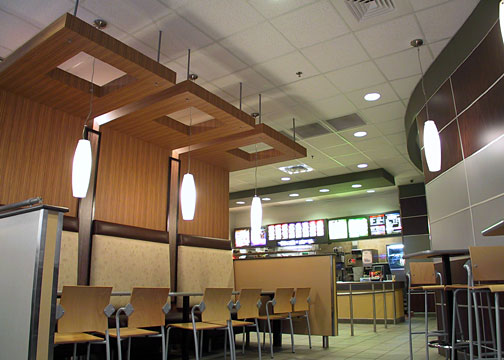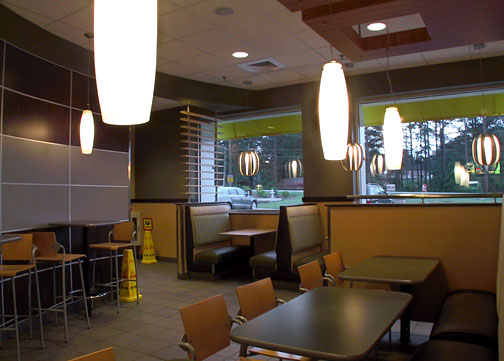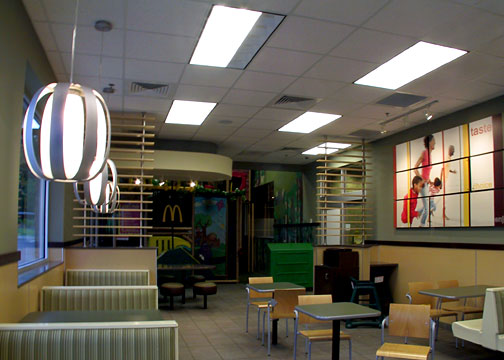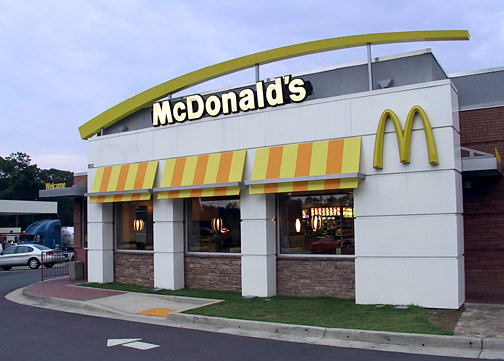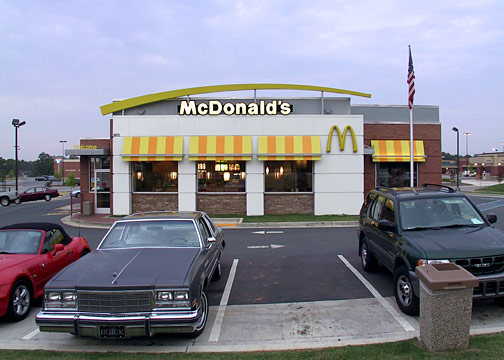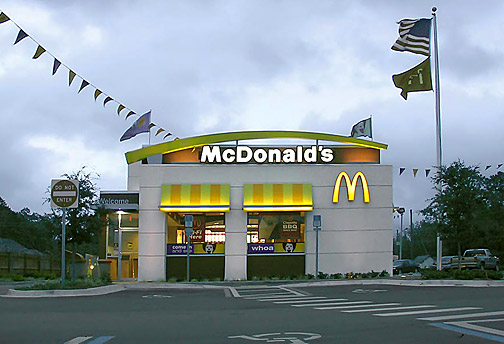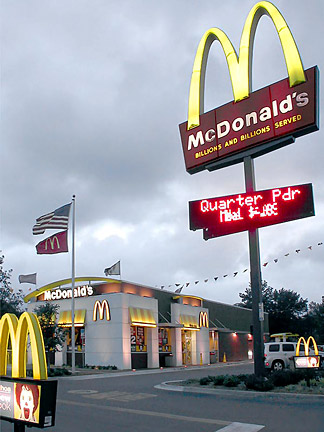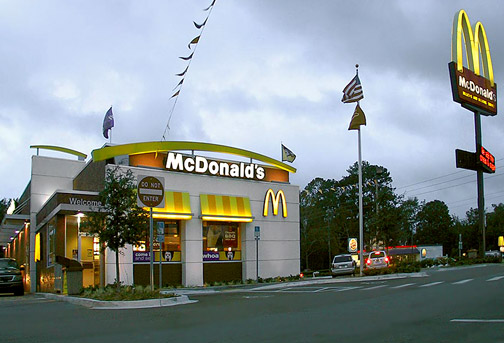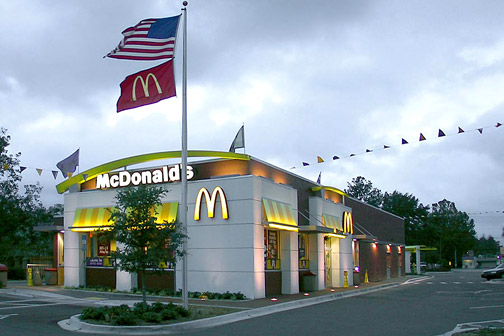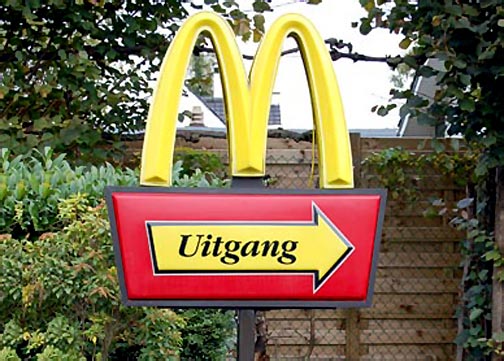|
| Photos
July 10, 2006: Kummerlowe Archive |
| |
From
Golden Arches to Swish Brow
By 2003, with Ray Kroc's McDonald's Corporation nearly 50 and
the McDonald's fast food restaurant concept itself old enough
to qualify for AARP membership, the brand had perhaps become too
familiar and sales figures stalled. Analysts, management, owners,
and customers alike recognized that the aged chain required revivification.
The question in need of solution was: How should McDonald's reinvent
itself without losing its core values and maintain relevance in
the marketplace.
It
was quickly determined that focus on customer experience was key
in reversing the slippage. Then, a new global marketing campaign
was adopted which was designed around the notion of a "Forever
Young" theme. Unleashed in September of 2003, the campaign
featured youthful images, hip music, and pop culture celebrities
touting the tagline, "I'm lovin' it." Next, James R.
Cantalupo was called back from retirement to head the corporation
and its efforts to recapture golden luster. His plan was to keep
things simple with a focus on the basics like customer service,
clean restrooms, and reliable appealing food (not unlike McDonald's
Corporation founder Ray Kroc's mantra of QSC and V--Quality, Service,
Cleanliness, and Value). In addition to the basics he determined
to position the company with a more modern coherent image in order
to foster a McDonald's "experience" for customers. More
than an advertising campaign he and his team approved sweeping
new architecture for McDonald's restaurants--the first major overhaul
since 1969 when the now universally recognized signature double
mansard roof became standard. In fact, Mr. Cantalupo personally
approved abandonment of the ubiquitous and familiar mansard in
favor of what became the "Forever Young" prototype topped
with its swish eyebrow.
Cantalupo
did not live to see the fruits of his labor, for he died in 2004
just as his modern vision for McDonald's was getting underway.
Nonetheless he had set things into motion causing a paradigm shift
for the company resulting in a refreshed image without a dilution
of brand identity.
|
|
Above,
Below & Lower: An early "Forever Young"
(swish brow) McDonald's north of Douglasville and west of Atlanta,
Georgia. |
|
| |
|
| |
| |
|
| |
| |
McDonald's
re-booted: From free wi-fi to zoned seating
In the past, no loitering had been McDonald's motto. Ray Kroc
had decreed upon the origins of his version of the chain that
pay telephones, juke boxes, and vending machines of any kind
were verboten at McDonald's restaurants. The goal had been to
quickly serve customers and not entice them to stay in the restaurants
any longer than it took them to eat a hamburger. Along that
line of thinking, dining areas were designed with minimalist
hard plastic tables and chairs which were more often than not
bolted in place. Thus customers consumed their fast food in
scant comfort without dillydally allowing room for the next
hurried patrons!
With
Forever Young, McDonald's turned a new page for itself. New
and remodeled restaurants feature dining zones with "distinct
personalities." Most will offer three sections or zones.
A linger zone is designed to accommodate young
adults who might dawdle and socialize while sitting comfortably
on armchairs or sofas using free wi-fi. Another zone offers
counters and stools for patrons in a hurry who might just grab
and go. The third and perhaps most important zone is
the one for families or groups where seating
arrangements can be reconfigured to meet a variety of needs.
Moreover harsh colors and hard plastics have been replaced with
custom earth tones and flexible padded fabric covered booth
seating all in hopes of engaging diners to loiter and perhaps
spend more money. Finally in addition to architecture and furnishings
McDonald's menu has been tweaked to offer a larger variety of
what the corporation refers to as more healthful food (but
I'll stick with the old standbys!).
Like
it or not, franchisees are required to abide by the dictums
of their parent and perhaps more than a few have complained
about the Forever Young mandated changes. First people the world
over recognize the mansard buildings and identify McDonald's
with them. A new look might unground potential patrons. The
next objection is cost. In 2008 a new build swish-brow store
was said to cost upwards of $1 million and renovation of an
existing unit to meet the new standards as much as $400,000.
With a large percentage of sales from drive-in business franchisees
could argue that the expensive interior redesign is unwarranted
for their bottom lines.
|
|
Just
how much will Corporate bend to its franshisees objections, and
is the swish-brow too high brow--too Eurolooking for the very
symbol of American roadside capitalism? |
|
| |
|
| |
| |
|
| |
| |
|
| |
| |
|
| |
| |
|
| |
| |
|
| |
| |
| Photos
October 2007: Kummerlowe Archive |
|
| |
| |
| |
Above,
Below & Lower: Small-sized swish-brow in Callahan,
Florida. |
|
| |
|
| |
| |
|
| |
| |
|
| |
| References
and Sources: |
| |
| "Big
Mac Museum Restaurant-About McDonald's." Our Company-About McDonald's.
McDonald's Corp. 14 Feb. 2010 <http://www.aboutmcdonalds.com/mcd/our_company/museums/big_mac_museum_restaurant.html>. |
| |
| Hess,
Alan. Googie: Redux. San Fransisco, CA: Chronicle Books LLC,
2004. |
| |
| "History
of the Historic Site of the Original McDonald's in San Bernardino."
www.route-66.com/Colonel 66 Internet Productions. 29 Jan. 2003. 14
Feb. 2010 archived in the Internet Archive accessed via the wayback
machine. <http://web.archive.org/web/20080209022128/http://www.route-66.com/mcdonalds/history.htm>. |
| |
| Jackle,
John A, Keith A. Sculle. Fast Food: Roadside Restaurants in the
Automobile Age. Baltimore, MD: The Johns Hopkins University Press,
1999. |
| |
| Jones,
John, Herb
Ruard. Let's Eat Out. Chicago, IL: Melmont Publishers, Inc.,
1965. |
| |
| Kroc,
Ray A, Robert Anderson. Grinding it Out: The Making of McDonalds.
New York, NY: St. Martin's Press, 1987. |
| |
| Langdon,
Phillip. Orange Roofs, Golden Arches: The Architecture of American
Chain Restaurants. New York, NY: Alfred A. Knopf, Inc., 1986.
|
| |
| Liebs,
Chester H. Main Street to Miracle Mile. Baltimore, MD: The
Johns Hopkins University Press, 1995. |
| |
| Loeffler,
William. “Big Mac Museum opens in North Huntingdon.” Pittsburgh
Tribune-Review , 22 Aug. 2007 <http://www.pittsburghlive.com/x/pittsburghtrib/news/westmoreland/s_523320.html#>. |
| |
| "McDonald's
#1 Store Museum." Our Company-About McDonald's. McDonald's Corp.
14 Feb. 2010 <http://aboutmcdonalds.com/mcd/our_company/museums/first_store_museum.html>. |
| |
| "Big
Mac © Museum-The most tasteful museum in the world." Big
Mac Museum Website. 14 Feb. 2010. <http://www.bigmacmuseum.com>. |
| |
| Tennyson,
Jeffrey. Hamburger Heaven. New York, NY: Hyperion, 1993. |
| |
| Your
Guide to Pennsylvania's Laurel Highlands 2009. Laurel Highlands
Visitors Bureau travel guide 2009. |
| |
|
| Photo
Credits: |
| |
| Kimbrough,
Justin |
Stuart,
Florida |
| |
|
| Reine,
Emilie |
Overijse,
Belgium |
| |
|
| Riehle,
Thelma |
Sedona,
Arizona |
|
|
|
| |
| |
| |
| Photo
October 2008: Emilie Reine |
| |
Above:
Exit sign at the Overijse McDonald's near Jezus-Eik, Belgium. |
|
| |
|
|
 |
